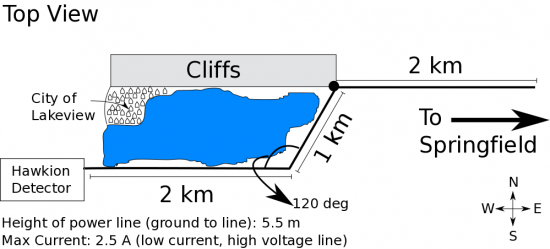Project: Lakeview's Mystery
You've just received a phone call from the head of the Wildlife Tracking Foundation of Lakeview. Dr. O'Taulest has been reporting that they have recently had an unprecedented disappearance of their green-bellied canaries that like to roost in the cliffs overlooking the lake. Their most popular nesting area on the eastern edge of the cliffs is completely empty. It's almost like they decided to migrate 4 months ahead of schedule! The Wildlife Tracking Foundation is also reporting that the fish, especially those near the north-eastern bank of the lake, have suffered a sudden decrease in their population. Dr. O'Taulest claims that it is all your fault since you had to build a large power line to run the Hawkion detector. Clearly, the magnetic field from the power line interfered with the green-bellied canaries (who rely on Earth's magnetic field for migration purposes), causing their vacation from the vicinity.
As consultants on the Hawkion project, you have been asked to kindly disprove Dr. O'Taulest's claims. The government does not need any more press about Lakeview getting out given the continued storm front inhabiting the town. To start, you go back and consult the handy-dandy blueprints you drew up when designing the transmission line.

Learning Goals
- Use the right hand rule to determine the direction of the magnetic field near a wire.
- Calculate the magnetic field from a wire segment with a current and explain the role of superposition in your solution.
- Explain what the pieces of the integral are ($d\vec{l}$, $\vec{r}$, and limits) and how you determined them for your solution.
- Relate the magnetic field from a current to the magnetic field from a single moving charge - explain how these are similar and/or different.
Conceptual Questions:
- How do you decide what the separation vector is for a current wire?
- How do you pick the bounds for the B-field integral?
- What steps do you take to set up the B-field integral?
- How is the magnetic field equation for a current wire similar/different from the magnetic field equation for a point charge?
- How is the right hand rule for a current wire similar/different to the right hand rules from last week?
- What assumptions did you make in this problem? What are the impact of those assumptions on your solution?